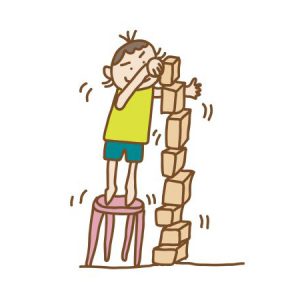
Last Updated on August 3, 2023
Have you ever suspected that your child sees things differently than you see them? Or, do they seem to bump into every obstacle that gets in their way? Problems like these are sometimes a result of under-developed cognitive skills. In other words, it could be because your child has an issue with their skills in spatial reasoning. Visual spatial intelligence is something we use every day. It helps a child know where to sit on the school bus and where to place their book bag so others don’t trip over it. When there’s a problem with our visual spatial skills, life at school and at home becomes harder than it has to be.
If you’ve ever wondered how a sculptor looks at a block of clay and sees a beautiful statue hidden inside, you’ve thought about visual spatial intelligence. Visuospatial ability is a cognitive skill that lets you ‘see’ objects, even when your eyes are closed. It’s what someone means when they mention their ‘mind’s eye.’ Sometimes we call this skill ‘spatial reasoning.’
But there’s another way to describe visual spatial intelligence, too. It’s also how we see visual objects and where they’re positioned in space. You might call this orientation. The ability to look across a room and understand that the trash can is closer to you than the pencil sharpener requires the use of visual spatial reasoning. Many factors may impact visual spatial intelligence, and most won’t show up in a vision test. They include:
As you may anticipate, any of these may make it more difficult for a child to master a task. But diagnosing problems with visual spatial intelligence often requires the help of several professionals. If you suspect your child struggles with their visuospatial reasoning, talk to your pediatrician first. A referral to a pediatric or behavioral optometrist or to a neuropsychologist may help you find the answers you need.
Visual spatial intelligence is an important skill we must develop to get through our days unscathed. But problems with this processing skill also cause barriers to learning. When a child can’t quite grasp the concept of what’s on the table as opposed to what’s under the table, they may feel confused and overwhelmed. Similarly, if they can’t tell the difference between who is in line and who’s out of line, how will they know where to stand when the bell rings for lunch?
Children who have problems with their visual spatial reasoning may struggle in the classroom. They may frequently bump into things, have trouble paying attention, or be unable to tell numbers and symbols apart. Learning disorders such as dyslexia and dyscalculia involve problems with this processing skill, because children who have them may see letters or numbers reversed or upside-down.
But the problem will extend beyond the classroom. As humans, we use visual spatial intelligence all day, every day. When we tie our shoes or read a map, we use it. We use it when we dance or operate a keyboard, too. And much like sculptors use spatial reasoning to create statues, architects use it to design buildings. Spatial reasoning is necessary to help us perform even the most mundane tasks, such as climbing stairs or walking to the end of the block.
Unfortunately, children don’t just outgrow problems with spatial reasoning. However, they can learn to manage and adapt to the conditions through experience and practice. As a parent, you can help by practicing visual spatial intelligence with your child at home.
You can help your child gain a better understanding of where objects are by using words such as ‘left, right, under, on top, next to, in, or nearby.” For instance, as your child is getting dressed in the morning, try giving him directions to find the necessary items. “Your shirt is in the dresser drawer.” or “Your shoes are under the bed.” And you can help kids refine their motor skills by taking them to the park to play on the jungle gym or by giving them ample practice with construction toys, sand tables, and clay.
Asking your children to perform tasks on their own can also help them gain confidence in their visual spatial reasoning. As they repeatedly complete tasks like cleaning their room, cooking a meal, pouring their own cereal, etc., they will gain new awareness of what they are doing and feel confident that they are able to do things on their own.
You can also encourage your child to draw the things he sees. In this way, you’ll have a more realistic idea of how objects appear to him. Then draw your own rendering of the same item, and compare the differences.
Mapping is a great activity for children who struggle with spatial reasoning. Help your child draw a map of your living room, your home, or their bedroom. Do this from memory and then use the map to walk around the room and compare where things are located. Or, you can explore printed maps with your child. Topographical maps are ideal. Let your child feel the mountains and valleys as you explain to them what each item represents.
Packing luggage is another activity that may help a child better understand how things fit into a space. Help your child pack an overnight bag, putting in shoes, shirt, pants, underwear, and anything else they anticipate needing for an overnight stay. In this way, they can visualize how many things fit into a suitcase. They can also practice different ways of placing items in the case to pack more efficiently.
Imagining is a good activity, too. Ask your child to envision where their favorite toy is located before sending them into their room to retrieve it.
Some boxed games are perfect for improving spatial reasoning. These include Jenga, Perfection, Pick Up Sticks, and Marble Race. Other toys, such as Lincoln Logs, LEGOs, and MEGA Bloks give children practice, as well. And video games like Tetris are beneficial, too. In fact, research shows that children who play video games tend to score higher on visuospatial tests. And children with higher levels of spatial reasoning usually do better in mathematics and science.

Still, children tend to mature according to their own individual schedules, and sometimes what you may think is a spatial reasoning issue is simply a clumsy stage. It takes an expert in the field to diagnose this type of disorder. So, if you suspect something unusual is happening with your child’s cognitive development, a trip to the pediatrician should be the first course of action.
The internet is filled with great resources for further reading. If you still have questions regarding your child’s grasp of visual and spatial reasoning, the links below may help.
Pre-K Spatial Reasoning, by Kumon Publishing